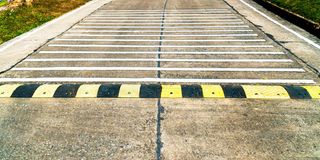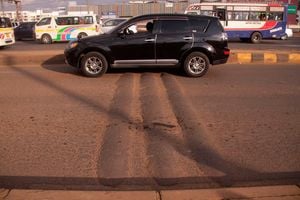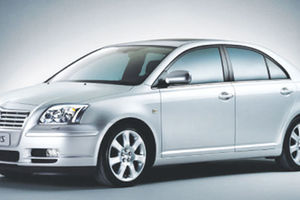
Any bump that does not comply with those requirements undermines the principle (“calming”) of speed bumps and is against the law.
When motorists see the new “rumble” strips are they supposed to immediately slow down, cross the strips very slowly, and then remain slow until they reach the subsequent speed bump? A high proportion of vehicles do that, often surprising the vehicles following them and greatly increasing the delay and tailbacks that strips and bumps cause. MT.
Rumble strips should be designed for vehicles to cross them at ambient cruising speed without any adjustment, discomfort, or risk. Their job is to give a non-visual warning (a very mild vibration transmitted through the tyres and suspension to the driver and steering wheel) that there is a hazard further ahead and drivers should prepare to slow down for it... after (!) they have crossed the rumble strips.
Clearly, the distance between the warning rumble and the speed bump should be designed to enable that. By the same international standard, the speed bump itself should be signposted in advance, it should have vertical posts with a red reflector on the left and a white reflector on the right to show exactly where the bump is, and the bump itself should be dyed or painted in a bright contrasting colour.

A bump that is acceptable on a city street, is different from a bump on a major highway.
Because the purpose of a bump on a highway is to “calm” traffic, not to bring it to a near-halt, it should never be more than 15cm high, and at that maximum height, it should be at least 4 metres long so vehicles can cross it safely and comfortably at up to 75 per cent of the prevailing speed limit. It should usually be possible to cross a speed bump comfortably and safely by simply easing off or gently braking. If a change of gear is required on approach or departure, the bump is too big.
Any bump that does not comply with those requirements undermines the principle (“calming”) of speed bumps and is against the law! It should not cause an undue or obstructive concertina of traffic flow. It should most definitely not cause loss of control or any damage if, for whatever reason, a vehicle unwittingly hits a bump at a higher speed.
A bump that is acceptable on a city street, is different from a bump on a major highway. The correct shape and height for a highway bump is best illustrated on the dual carriageway between Kikuyu when descending towards Dagoretti. On an open road, no bump should ever be more severe than those.
There is a Kenya Bureau of Standards standard with the authority of an Act of Parliament, which specifically defines these stipulations. Nowhere in that standard is there a suggestion that an MP, a county official, a roads engineer, a contractor, an inspector, a local community, a state, a social or religious institution, or a private business can do their own thing on a national highway. There is, presumably, a national authority with a specific mandate and responsibility to ensure compliance.
There are many thousands of examples where these requirements have been ignored, and which the systems for control and correction have (for some reason) overlooked, even though the consequences in danger, damage, time, operating cost, fuel consumption, exhaust and noise pollution, and congested traffic flow run into an added national transport cost of many, many billions per year.

On your specific rumble strips, this “physical” warning is just a signal—an excellent backup in case visibility is poor or other “visual” warnings are missing.
As an idea, rumble strips are heartily welcomed by all. But they do need to be designed and installed properly. If any (!) vehicle cannot cross them safely and comfortably at ambient speed, either the strips’ design is wrong, or the vehicle’s suspension is defective, or the driver is incompetent. Take your pick.
We need to form or wake up an association of automobilists, with a remit to represent motorists by, among other things, measuring the height and length of a selection of speed bumps and presenting these dimensions, with pictures, to the relevant authorities. With the combined voice of two million vehicle owners, either the existing law needs to be officially scrapped, or the existing bumps need to be changed.
Even if built correctly, bumps should be regarded as a desperate measure used only as a last resort. Rumble strips should be used only as an advance warning and deliver no more than a “thrum” to any vehicle at cruising speed. Traffic police would do well to flag vehicles, which slow down for rumble strips and find out why. Is it the strip, the vehicle or the driver that is unroadworthy?
Do we have an accident ‘blank’ spot?
How much effort and skill do our road safety officials apply to analysing road accidents, to ensure the statistics are meaningful and accurate? Policymakers give us their conclusions, but zero facts on the method or basis of those findings. The phrase “rubbish in, rubbish out” springs to mind. Data Analyst.

Strategic causes of accidents are often obscure, complex, and can be far removed from the scene of an eventual failure.
Let me introduce you to Joseph, who has a severe injury on the top of his head. He was standing in the middle of a room when a heavy light fitting hanging on a chain fell from the ceiling and landed on him.
The people who investigate our road accidents would probably report the cause of this incident as a “falling light”, and start composing a new knee-jerk law or crackdown to improve safety. For example, hanging lights must not weigh more than one kilo and must have independently mounted secondary safety chains. But a falling light was not the cause – merely one of the “circumstances”. The strategic question is: why did the light fall? Did the chain break or did the mounting hook rip out?
And why did either of those things happen? Was there a manufacturing fault, or defective installation, or was the chain/hook not strong enough for the light’s weight? Or was a good fitting using strong materials progressively worn and weakened by some unexpected factor?
So in an accident investigation you are not just asking what happened, or how it happened; you’re asking “why”, and when you have answered that you ask “why” again, and again, and as many times as necessary until there are no more “why’s” to ask. Only then is the answer “strategic” enough to be a valid basis for remedial policy or law.
So why did the light fall? Because the chain holding it broke. Why did the chain break? Because a weld in one of its links was weak. Why was the weld weak? Because it moved to-and-fro in the breeze from a fan and rubbed on the ceiling hook until it was worn away. Why did it wear so easily…and so on, and so on.
That is, of course, just a hypothetical example. A deliberately bizarre one. Just to illustrate how thorough (and thoughtful) analysis must be to establish the real “root cause” of a consequence, which is essential to any realistic preventive action. Anyone involved in modern “quality control” will be familiar with the process.
Strategic causes are often obscure, complex, and can be far removed from the scene of an eventual failure. Especially in road accidents. Speed, for example, is always one of the circumstances of an accident but it is almost never the main or only cause. As the saying goes, jumping off a skyscraper doesn’t kill you; hitting the pavement does. And the consequence is the same whether you fall from the fourth floor or the 18th.
How well do officers who attend traffic accidents distinguish between “circumstances” and real “cause”? What actual words do they write in the book? And how do the statisticians translate those into a themed graph or table that guides road safety administrators? And on what basis and by whom are those squiggles and numbers turned into policy imperatives, and then drafted into law? Who is sitting at the table? What are their qualifications? What are they told by data? What do they think? What do they say? Who is listening?
Some of those questions can be answered… by working backwards. Presumably the most obsessive laws and enforcement priorities are based on the most compelling statistical evidence from the most informed source.
Judging by the roadside priorities of traffic police, the latest traffic legislation, and the glaring issues completely overlooked by the road safety barons, that whole process clearly doesn’t start, or end, well.
If the excuse is a lack of capacity and training, then woah! Why and why? Only if we know the cause (not just the circumstances) can we design the cure.
It is nigh certain that 99 percent of road deaths are caused by human error—before, during or even after the crash itself. What are the primary mistakes, and what is causing them? Inadequate tuition and testing? Vehicle condition? Driving mistakes? Mechanical errors? Rough roads? Drainage failures? Bad traffic design? Misplaced enforcement? And for each of those, why, why and why?
It is the answer to those questions that will best determine what should be done.
Tech tips on exhaust pipes
I dented my exhaust pipe on a big rock. It did not break, doesn’t leak and the car runs okay. Can I just carry on or should I have it fixed? EN.
Short answer: If the dent is minor it can probably be ignored. If it is deep enough to significantly restrict the flow of exhaust gases—loss of power, increase in fuel consumption—it should be fixed by removing the damaged section and fitting a “sleeve” to replace it.

If an exhaust leaks, all these functions fail to some degree.
Exhaust pipes do three jobs. They carry hot and toxic gases from the engine (usually at the front) and release them out the back so they do not discomfort or poison passengers or foul the bodywork; they “muffle” the tremendous noise that a working engine generates; and they create “back pressure”, which is necessary to correct and efficient combustion.
If an exhaust leaks, all these functions fail to some degree. Obviously the size of the leak is crucial but so, too, is its position. The nearer the engine a leak occurs, the more serious the failure.
Leaks near the engine manifold should be attended to as a high priority, as apart from the danger of toxins and noise that assaults everybody in the vicinity, the loss of back pressure can cause overheating and rapid and severe engine damage (burnt exhaust valves).
Exhaust pipes wear out mainly because of corrosion, which causes leaks. But dents in the pipe are also serious, as they restrict the flow of gases too much, reducing performance and increasing fuel consumption. If your car suddenly becomes sluggish, and all else seems to be in good working order, then a restriction in the exhaust pipe is a possible cause.
If an exhaust is in generally good condition, repairs of leaking or dented sections are a feasible alternative to replacing the whole system. But welding is not the best fix—it will promote more rapid corrosion of the surrounding pipe.
The best repair is to cut out the damaged section and replace it with a new length of pipe - again not welded into place but joined as a tightly fitting sleeve with an overlap of 5-10cm at each end. All competent workshops should be able to achieve this sleeve process, known as “swaging”.












